
The world of lighting is undergoing a significant transformation, driven by technological advancements and the increasing demand for smart home solutions. Among these innovations, the WiFi light switch has emerged as a pivotal component, reshaping how consumers interact with their lighting systems. This article delves into the growing importance of WiFi light switches in the lighting industry, exploring their benefits, applications, and the future they promise.
WiFi light switches are smart devices that allow users to control their lighting remotely via a smartphone app or voice commands. Unlike traditional light switches, which require physical interaction, WiFi switches integrate seamlessly with home networks, enabling users to manage their lights from virtually anywhere. This technology represents a significant leap forward in convenience and functionality. With the rise of smart homes, these devices not only enhance the aesthetic appeal of a space but also contribute to energy savings and improved security.
At the core of a WiFi light switch is its ability to connect to the home’s wireless network. When installed, these switches communicate with a router, allowing users to control their lights through an application on their smartphones or tablets. Many models also support voice control through smart home assistants, providing an additional layer of convenience. The integration of WiFi technology means that users can easily update their settings or troubleshoot issues from anywhere, making it a user-friendly solution for modern living.
Installation typically involves replacing existing light switches, which can often be done without professional help, although consulting with a lighting contractor is advisable for optimal setup. Once connected, users can schedule lighting, adjust brightness, and even change colors, depending on the switch’s capabilities. This flexibility allows for personalized lighting experiences, such as creating a cozy atmosphere for movie night or brightening up a space for a productive work session. Moreover, many WiFi light switches are designed to work with existing smart home ecosystems, allowing for further automation and integration with other devices.
WiFi light switches come equipped with various features that enhance their usability. Some notable functionalities include:
In addition to these features, many WiFi light switches also offer customizable scenes and moods, allowing users to create specific lighting settings for different activities or times of day. For example, a user might set a “Relax” scene with warm, dim lighting for evening unwinding or a “Focus” scene with bright, cool light for working from home. Furthermore, some advanced models include compatibility with IFTTT (If This Then That) services, enabling even more automation possibilities, such as having the lights turn on when the front door is unlocked or when a security camera detects motion. This level of integration not only enhances the functionality of lighting but also contributes to a more connected and efficient home environment.
The adoption of WiFi light switches offers numerous advantages that appeal to both consumers and lighting contractors. Understanding these benefits can help contractors better serve their clients and position themselves as experts in the smart lighting domain.
One of the most significant advantages of WiFi light switches is the convenience they provide. Homeowners can control their lighting from anywhere, eliminating the need to physically walk to a switch. This feature is particularly beneficial for those with mobility challenges or for families with young children who may forget to turn off lights.
Moreover, the ability to schedule lights to turn on or off at specific times can enhance home security, giving the impression that someone is home even when the house is empty. This feature can deter potential intruders and provide peace of mind to homeowners.
WiFi light switches contribute to energy efficiency in several ways. By allowing users to turn off lights remotely, they help prevent unnecessary energy consumption. Additionally, scheduling features enable homeowners to optimize their lighting usage, ensuring that lights are only on when needed.
Some advanced models even provide real-time energy monitoring, allowing users to track their consumption patterns and make informed decisions about their lighting usage. This data can lead to significant savings on electricity bills over time.
WiFi light switches can easily integrate with other smart home devices, creating a cohesive and automated living environment. For instance, they can work in conjunction with smart thermostats, security systems, and home assistants, allowing for synchronized control and enhanced functionality.
This integration not only improves user experience but also positions WiFi light switches as a central component of a smart home ecosystem. As more consumers adopt smart technology, the demand for compatible lighting solutions will continue to grow, presenting opportunities for contractors to expand their offerings.
WiFi light switches are versatile and can be used in various settings, from residential homes to commercial spaces. Understanding their applications can help contractors identify new markets and tailor their services accordingly.
In residential settings, WiFi light switches are increasingly popular among homeowners looking to enhance their living spaces. They can be installed in various rooms, including kitchens, living rooms, and bedrooms, allowing for customized lighting solutions that cater to individual preferences.
For families, the ability to control lighting remotely can be especially appealing. Parents can turn off lights in children’s rooms from their smartphones, ensuring that lights are not left on unnecessarily. Additionally, the scheduling feature can help create routines, such as automatically dimming lights at bedtime.
In commercial environments, WiFi light switches can significantly improve efficiency and reduce operating costs. Businesses can implement automated lighting systems that adjust based on occupancy or time of day, optimizing energy usage and enhancing the overall work environment.
Moreover, the ability to control lighting remotely can be invaluable for business owners who manage multiple locations. They can ensure that lights are turned off after hours, reducing energy waste and lowering utility bills. This capability also allows for quick adjustments during events or meetings, enhancing the overall experience for employees and clients alike.
WiFi light switches are not limited to indoor use; they can also be employed in outdoor lighting systems. Homeowners can control garden lights, patio lights, and security lighting from their smartphones, providing added convenience and security.
Outdoor lighting can be scheduled to turn on at dusk and off at dawn, ensuring that spaces are well-lit when needed while conserving energy during daylight hours. This feature is particularly beneficial for enhancing the safety and aesthetics of outdoor spaces.
While WiFi light switches offer numerous benefits, there are also challenges and considerations that lighting contractors must keep in mind when recommending these products to clients.
The effectiveness of WiFi light switches is heavily dependent on the reliability of the home’s wireless network. If the network experiences interruptions or slow connectivity, it can hinder the performance of the switches, leading to frustration for users.
Contractors should assess the network capabilities of their clients before installation and recommend solutions, such as WiFi extenders or mesh networks, to ensure optimal performance. Educating clients about the importance of a robust network can help mitigate potential issues.
As with any smart device, security is a significant concern when it comes to WiFi light switches. If not properly secured, these devices can be vulnerable to hacking, potentially allowing unauthorized access to a home’s lighting system.
Contractors should emphasize the importance of strong passwords and regular software updates to their clients. Additionally, recommending switches from reputable manufacturers with robust security features can enhance safety and build trust with clients.
Compatibility can be a concern when integrating WiFi light switches with existing smart home systems. Not all switches are compatible with every platform, which can lead to confusion and frustration for users.
Contractors should stay informed about the various smart home ecosystems and ensure that the products they recommend are compatible with their clients’ existing devices. Providing guidance on selecting the right switches can enhance the overall user experience and satisfaction.
The future of WiFi light switches looks promising, with continued advancements in technology and growing consumer interest in smart home solutions. As the lighting industry evolves, several trends are expected to shape the development of WiFi light switches.
As technology continues to advance, automation will play a more significant role in lighting control. Future WiFi light switches may incorporate artificial intelligence, allowing them to learn user preferences and adjust lighting accordingly without manual input.
This level of automation can enhance convenience and energy efficiency, making it easier for homeowners to create the perfect lighting environment for various activities and moods.
The demand for seamless integration among smart devices will drive manufacturers to develop WiFi light switches with enhanced interoperability. Future models are likely to support a wider range of smart home platforms, allowing users to mix and match devices without compatibility concerns.
This trend will empower consumers to create customized smart home ecosystems that cater to their unique needs, further solidifying the role of WiFi light switches in modern lighting solutions.
As sustainability becomes a priority for consumers, manufacturers will likely focus on developing WiFi light switches that promote energy efficiency and reduce environmental impact. This may include features such as energy monitoring, eco-friendly materials, and designs that minimize waste.
Contractors can play a vital role in promoting these sustainable solutions, helping clients make informed choices that align with their values and contribute to a greener future.
WiFi light switches are revolutionizing the lighting industry, offering unparalleled convenience, energy efficiency, and integration with smart home ecosystems. As technology continues to evolve, the importance of these devices will only grow, presenting opportunities for lighting contractors to expand their services and expertise.
By understanding the benefits, applications, and challenges associated with WiFi light switches, contractors can better serve their clients and position themselves as leaders in the smart lighting market. Embracing this technology not only enhances the customer experience but also contributes to a more sustainable and efficient future in lighting.
Ready to take the next step in smart lighting solutions for your clients? LumenWholesale is here to support you with an exceptional range of spec-grade WiFi light switches and other lighting products. Our commitment to quality, affordability, and convenience ensures that you can provide the best value in smart lighting technology. Say goodbye to inflated markups and hello to premium lighting at wholesale prices, complete with the ease of free shipping. Elevate your lighting projects by visiting Wholesale Lighting at the Best Value and discover how we can help you shine in the smart lighting market.

Illuminate your projects with precision using expert insights on 6-inch recessed can lights.

Discover how round solar lights can revolutionize the lighting industry by cutting costs for contractors.

Discover why lighting contractors should prioritize solar power lights for outdoor projects.

Discover expert strategies for lighting contractors to tackle the unique challenges of illuminating ballet studios with white backgrounds.